When it comes to tourism, Brazil needs little introduction. There is so much to see and do in this vast South American country, the fifth largest in the world!
Brazil is famous for so many things that it can mean something different to different people. For some, Christ the Redeemer is the first image that comes to mind when they think of Brazil. For others, it may be samba or carnival. For fans of sport and martial arts, football, Brazilian jiu jitsu, and capoeira come foremost to mind. And we can’t forget about Brazil’s beautiful beaches and gorgeous people!
First-time visitors will have their plates full in Brazil, but one thing that shouldn’t be overlooked is the food. Thanks to its size, history, and mix of different influences, Brazil is home to one of the most interesting cuisines not just in the Americas, but in the world.
Save This on Pinterest!
No time to read this article on Brazilian food? Click on the save button and pin it for later!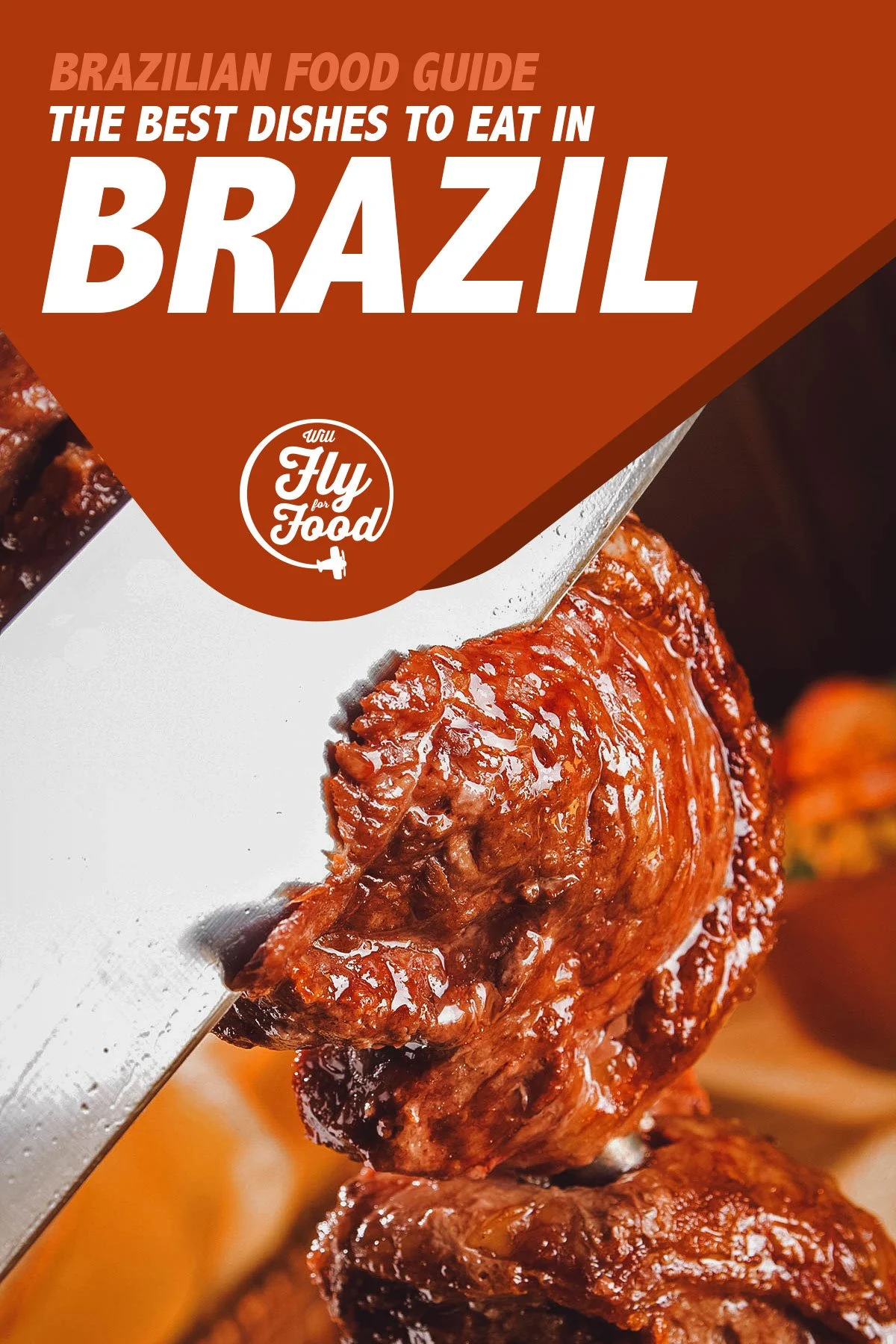
Photo by diogoppr
WHAT IS TRADITIONAL BRAZILIAN FOOD?
Brazilian food can be described as a fusion of indigenous ingredients with foreign influences, mostly Portuguese, West African, and Japanese. Thanks to its continental size, the food in Brazil can vary greatly from state to state and is a reflection of the country’s mix of native and immigrant populations.
Examples of common native ingredients include cassava root, yams, cashews, and açaí. European settlers introduced wine, dairy products, and leafy vegetables while enslaved Africans and Japanese immigrants brought with them dishes and techniques that have become important parts of the Brazilian diet.
Feijoada is widely considered to be the national dish of Brazil while caipirinha is its consensus national cocktail. However, defining a national cuisine becomes more challenging because of Brazil’s size and its mix of regional traditions.
For example, the food in northeast Brazil is heavily influenced by African cuisine while the southeastern city of São Paulo is home to the Asian-inspired pastel. Fish, fruits, and cassava are staple foods in the north but in the south, meat-based gaucho traditions like churrasco are more common.
In a way, this diversity of ingredients and influences – coupled with a desire to preserve these differences – is largely what defines traditional Brazilian food.
THE BEST OF BRAZILIAN CUISINE
This article on Brazilian food has been organized by category to make it easier to digest. Click on a link to jump to any section of the guide.
STARTERS / SIDES / SNACKS
1. Bolinhos de Bacalhau
Brazilians love their salgadinhos (appetizers or snacks) and bolinho de bacalhau is one of their favorites. It literally means “codfish cakes” and refers to croquettes made with a mixture of salt cod, mashed potatoes, eggs, onions, and parsley.
Bolinho de bacalhau is traditionally a Portuguese dish that’s become deeply rooted in Brazilian cuisine. They’re commonly eaten as an appetizer or snack but they can be enjoyed as a main dish with rice and vegetables as well.
Shaped like balls or small torpedoes, these tasty cod fritters are crunchy on the outside and soft and creamy on the inside.

Photo by Paulovilela
2. Coxinhas
If bolinhos de bacalhau look appealing to you, then you’ll probably enjoy coxinhas as well. They’re a popular street food snack made with battered and fried chicken meat covered in dough.
Coxinha (or coxinha de frango) literally means “little thigh” and refers to the snack’s distinctive tear drop shape. They’re meant to resemble chicken drumsticks which according to legend, can be traced back to Brazilian Princess Isabel’s mentally ill son. As the story goes, chicken thighs were his favorite dish so the cook shredded a whole chicken and created drumstick-shaped croquettes to appease him.
To make, a filling of shredded chicken, cream cheese, onions, scallions, and parsley is wrapped in dough enriched with chicken broth. They’re fashioned into drumsticks and coated in batter and breadcrumbs before being deep-fried till golden brown and crispy.
Coxinhas are traditionally filled with chicken meat but they can be made with other ingredients as well like corn, cheese, nuts, peas, mushroom, carrots, and other vegetables. Whatever they’re made with, they’re usually served with a side of hot sauce or mayonnaise.

Photo by fotek
3. Kibe
If you’re a fan of Lebanese food, then this next dish will probably be familiar to you. Kibe refers to the Brazilian version of kibbeh, a popular football-shaped croquette made with beef and bulgur wheat.
Lebanese kibbeh are often made with spiced ground lamb but in Brazil, beef is preferred. Ground beef is mixed with bulgur wheat and seasoned with onions, garlic, mint, and cinnamon. They’re typically deep-fried and served with tahini sauce and lime, but they can also be eaten raw (kibe cru) or baked in a casserole with cheese (kibe assado recheado).
Kibe made its way into Brazilian cuisine sometime in the late 19th and early 20th centuries after a wave of Levantine immigrants were welcomed into the country.
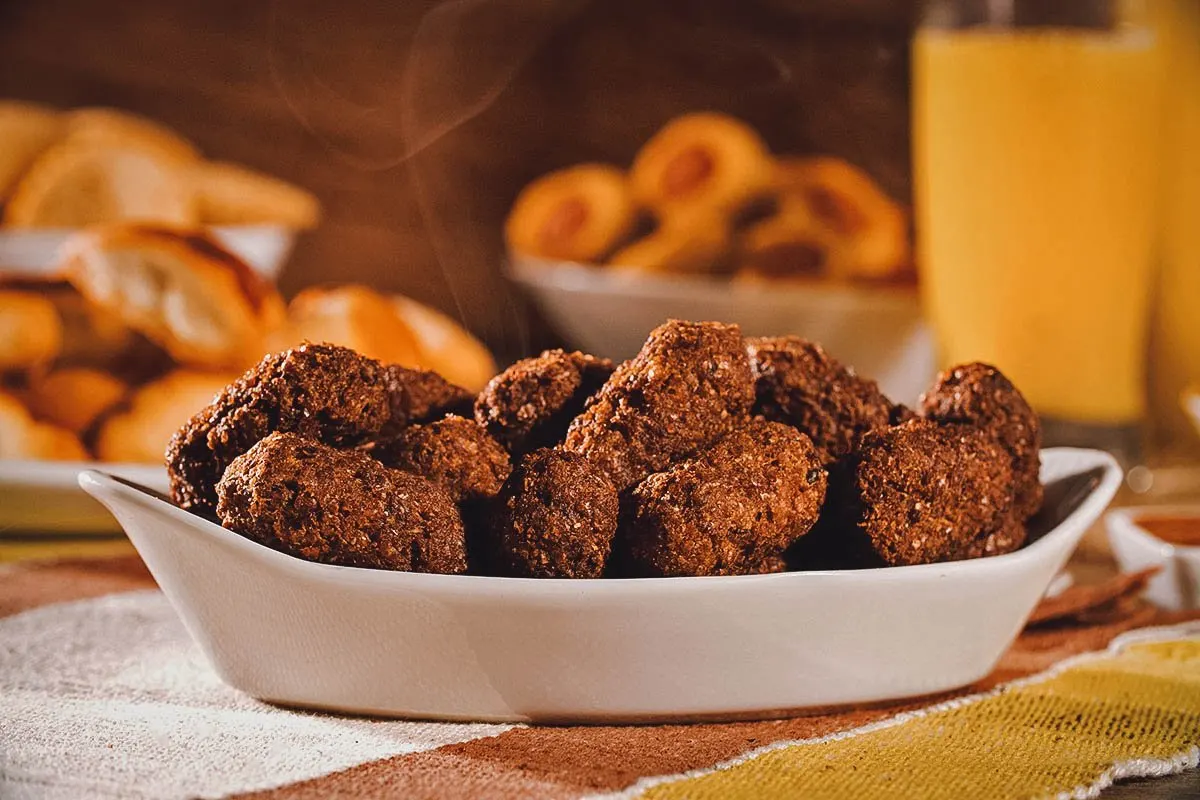
Photo by Paulovilela
4. Caruru
Caruru refers to a traditional Brazilian dish made with okra, dried shrimp, onions, and toasted nuts cooked in dendê or red palm oil. It’s a popular condiment in the Brazilian northeastern state of Bahia where it’s often eaten with acarajé (fritters made with black-eyed peas).
A Brazilian dish with African roots, caruru was initially brought to the country by African slaves working on the country’s sugar plantations. Today, it’s an important ritual food of the Candomblé religion and is the main meal served during the feast day of Saints Cosmas and Damian, twin saints regarded as the protectors of children in Brazil.

Photo by paulbrighton
5. Farofa
Farofa is a hugely popular side dish in Brazilian cuisine. It’s present at every churrasco and consists of toasted manioc flour (cassava flour) mixed with a variety of ingredients like onions, garlic, nuts, olives, bacon, raisins, and fresh herbs.
Together with rice and beans, farofa is the most commonly eaten side dish in Brazil. It’s smokey, buttery, and with a slightly crunchy texture similar to breadcrumbs. Farofa is typically sprinkled over grilled meats and savory dishes like feijoada and moqueca but it can also be used as a stuffing for Brazilian poultry dishes.
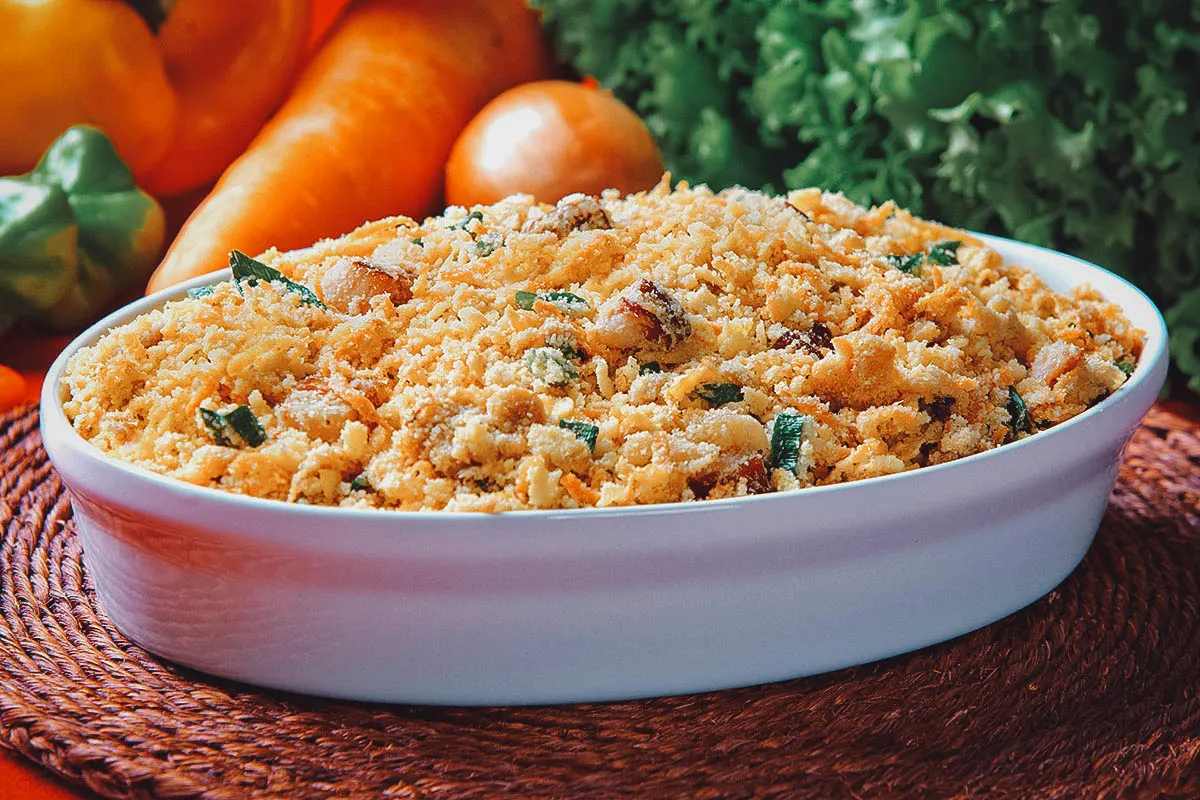
Photo by Paulovilela
6. Pamonha
The name pamonha is derived from the Tupi word for “sticky” and refers to the Brazilian version of tamales. Traditionally sold as street food in Brazil, it’s made with boiled and mashed sweet corn wrapped in corn husks.
Depending on what it’s made with, pamonhas can be either savory or sweet. Savory pamonhas are typically filled with sausage, chicken, peppers, or cheese while sweet versions are served plain or made with coconut milk mixed into the mashed corn.
Pamonha is consumed throughout the year but it’s traditionally associated with Festa Junina, an annual celebration that commemorates St. Anthony, St. John the Baptist, and St. Peter. Celebrated from mid-June till around the end of July, it marks the end of the rainy season and the beginning of the harvest.
Corn is one of the main crops harvested during this time so Brazilians express their gratitude for the rain by celebrating and enjoying snacks and cakes made from corn.

Photo by Paulovilela
SOUPS / STEWS
7. Camarão na Moranga
Camarão na moranga literally means “shrimp in pumpkin” and refers to a creamy Brazilian shrimp stew served in a roasted pumpkin. It’s a popular dish along the Brazilian coast that’s typically served with white rice and batata palha (fried grated potatoes).
According to one urban legend, the origin of this Brazilian stew can be traced back to a prison in Bertioga, along the coast of São Paolo. Japanese inmates started planting fruits and vegetables in the prison, among them pumpkins whose seeds they’d roast and use as a deworming agent.
It wasn’t long before people heard about this alternative treatment and started buying these pumpkins. One day, when pumpkins were being transported from the prison, one fell into the sea. It emerged a few weeks later about three miles from where it sank and was recovered by the owner of a restaurant by the beach.
The owner opened the pumpkin to find it full of shrimp. Inspired, she created the hearty stew we now know today as camarão na moranga.

Photo by paulbrighton
8. Moqueca
Moqueca refers to an aromatic Brazilian seafood stew that’s slow-cooked in a traditional clay pot called panelo de barro. It’s typically made with fish or shrimp cooked with other ingredients like tomatoes, onions, garlic, coriander, olive oil, and lime juice.
There are two well-known versions of moqueca in Brazil – moqueca baiana and moqueca capixaba. Influenced by African culture, the former hails from the north (Bahia) while the latter is from the southeast (Espírito Santo) and draws influences from Portuguese and Spanish cuisine.
Between the two, moqueca baiana is the bolder and more complex version thanks to the use of coconut milk, palm oil, and bell peppers in the recipe. Whatever the version, moqueca is a tasty Brazilian stew that’s best paired with white rice, pirão de peixe (fish gravy), or farofa.
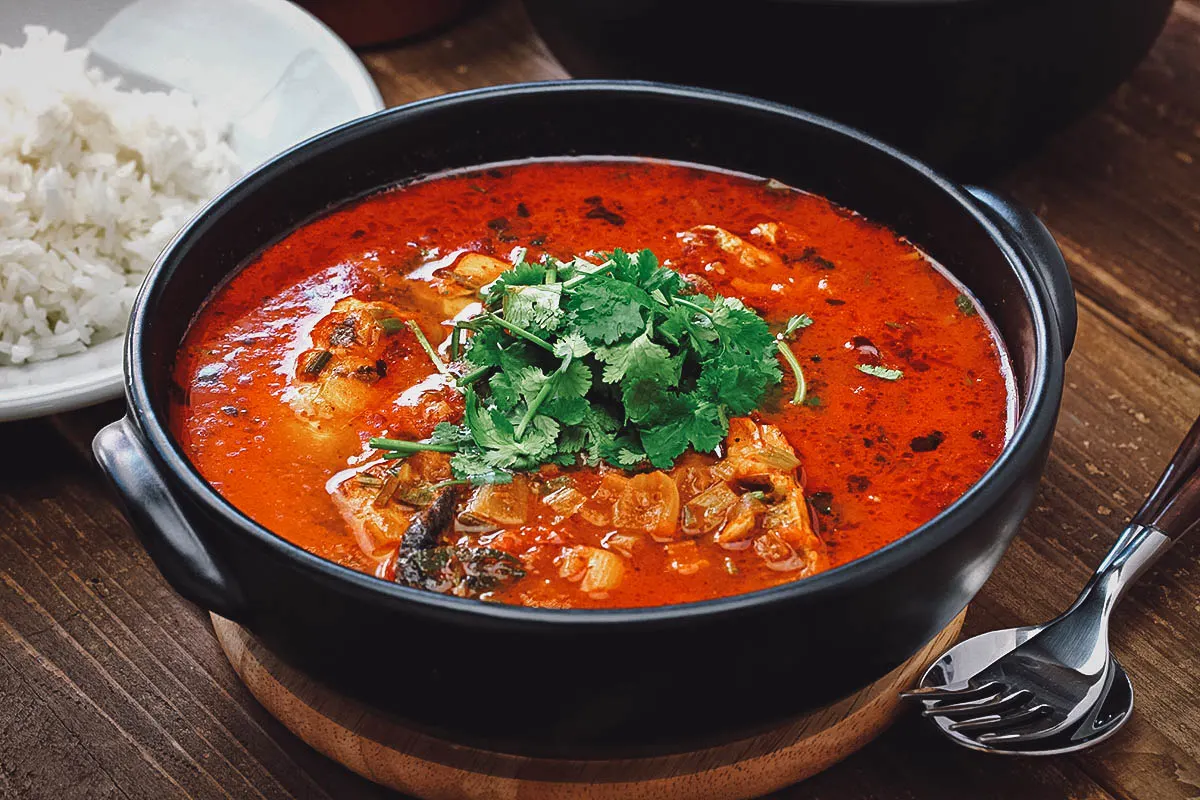
Photo by asimojet
BREADS / PASTRIES
9. Pão de Queijo (Cheese Bread)
Pão de queijo is a widely consumed type of Brazilian cheese bread. Originally from Minas Gerais in southeastern Brazil, it refers to small baked cheese rolls or cheese buns that are commonly eaten for breakfast or as a snack.
Brazilian cheese bread is made with tapioca flour, cheese, milk, and eggs. Like many popular Brazilian foods, it was invented during the time of the Portuguese occupation. Wheat products weren’t readily available at the time so slaves would make bread rolls out of cassava root. When milk and cheese became more widely available, they were added to the tapioca roll to create the pão de queijo enjoyed throughout Brazil today.
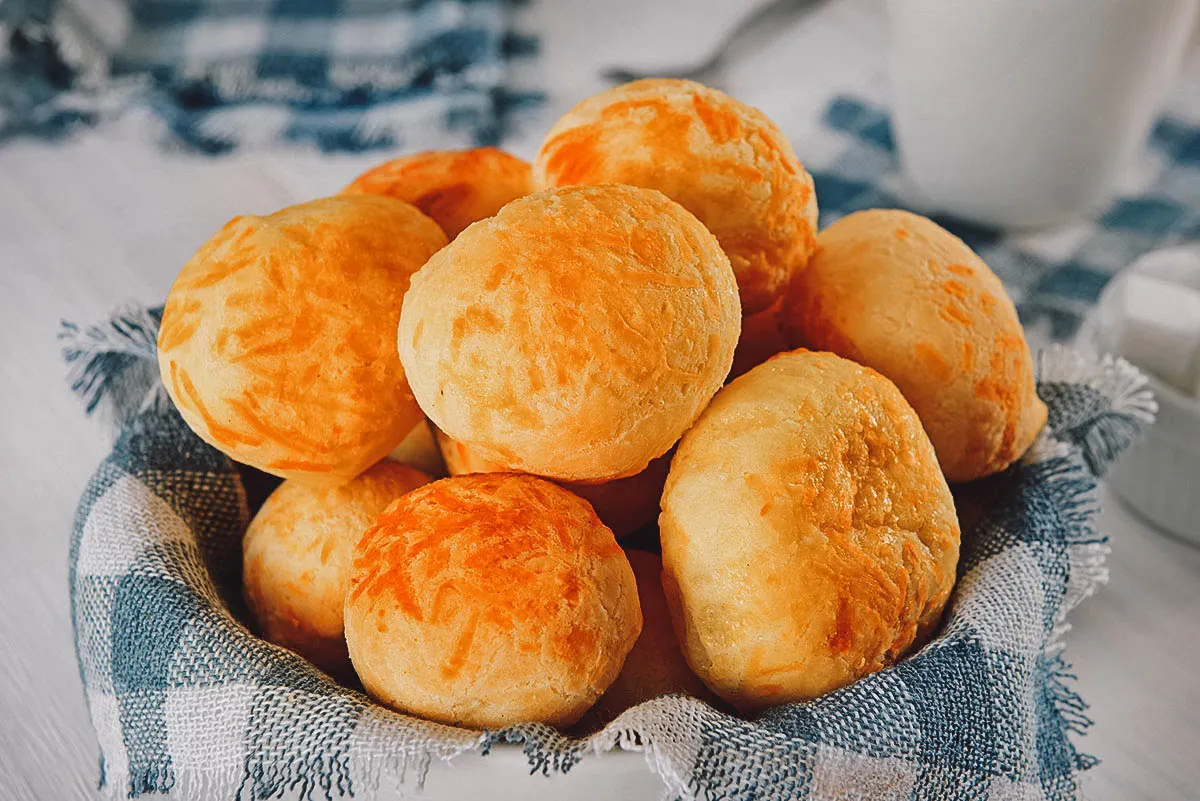
Photo by MKPK
10. Pastel
The pastel is one of the most common street foods in Brazil. Similar to an empanada but with a thinner and crispier outer layer, it refers to a deep-fried pastry filled with a variety of ingredients like cheese, ground beef, chicken, shrimp, and heart of palm.
It’s unclear where the pastel originated from but they may have been derived from Chinese spring rolls or wontons brought to Brazil by Japanese immigrants. They’re typically savory but they can also be sweet, filled with dessert ingredients like bananas, chocolate, or guava paste.

Photo by betochagas
Here’s an inside look at the filling of a Brazilian pastel. They can be made into half-moon or rectangular shapes. The former is more commonly served at Brazilian bars while the latter can be found at street market stands and beachside kiosks. Rectangular pastéis are often referred to as pastel de vento (windy pastel) in reference to their large crusts half-filled with air.
No matter the shape, pastéis are a common street food or fast food snack in Brazil that’s often enjoyed with Brazilian beer or caldo de cana (pressed sugarcane juice).
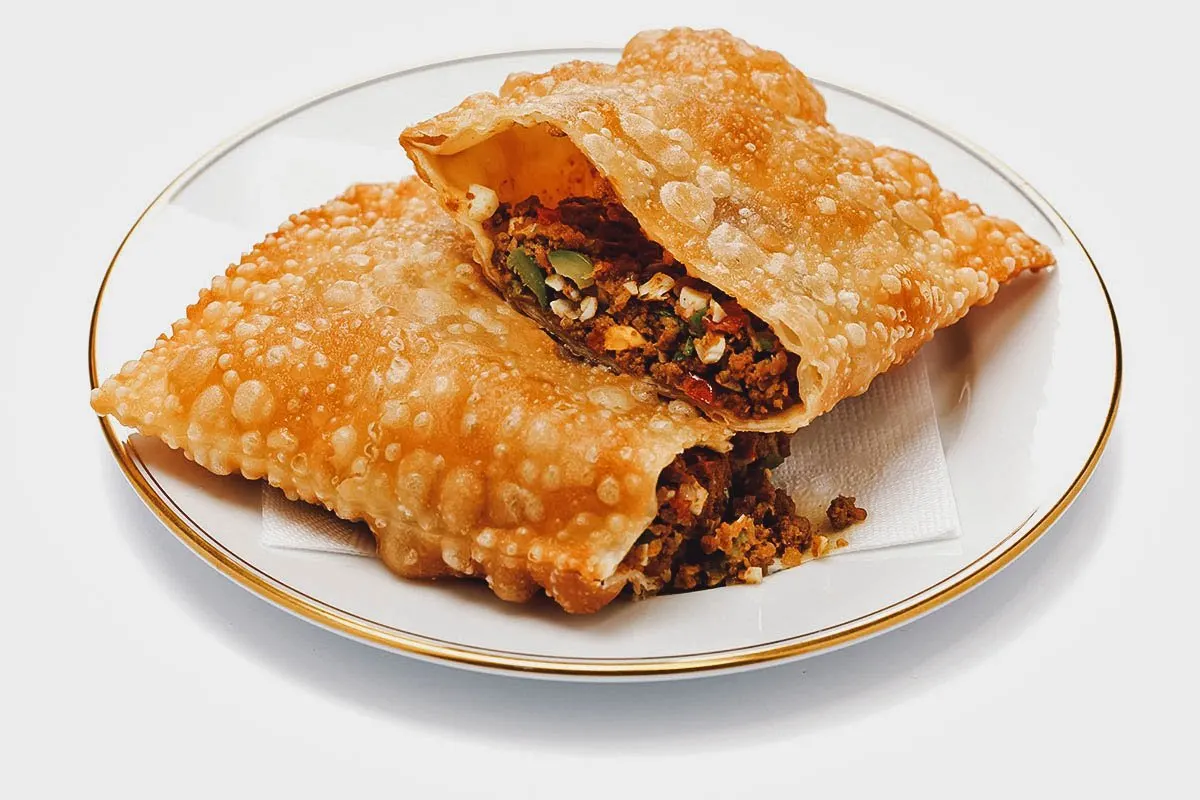
Photo by betochagas
11. Empadinha
An empadinha is a small savory Brazilian pie. It’s a common appetizer or snack in Brazil made with a flaky and buttery crust filled with a variety of ingredients like heart of palm, chicken, shrimp, cheese, dried meat, salt cod, and vegetables. It’s basically the diminutive version of the empada, a regular-sized pie that’s often served for dinner in Brazil.
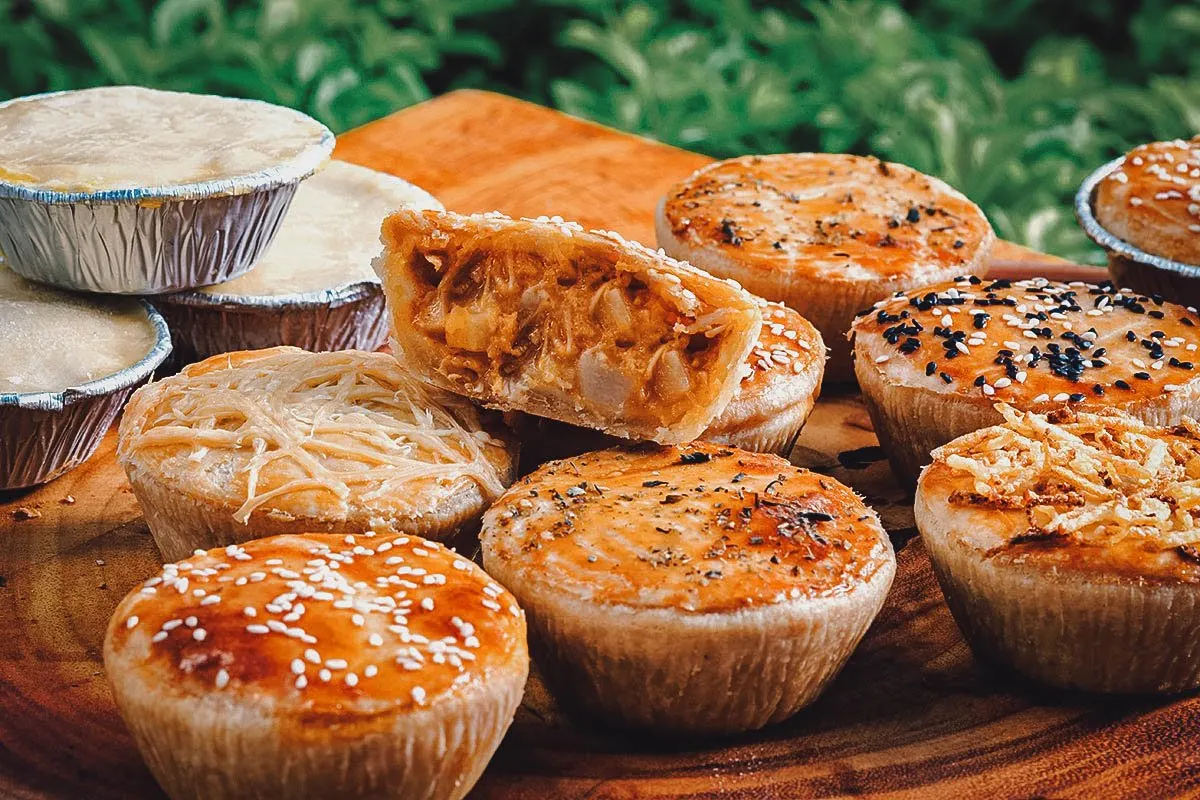
Photo by rocharibeiro
12. Esfiha
Like kibe, esfiha (or esfirra) refers to the local equivalent of a well-known Levantine dish. It’s the Brazilian version of sfiha, a popular flatbread dish topped with minced lamb, onions, tomatoes, pine nuts, and spices.
In Brazil, esfiha can be made in the traditional flatbread shape or folded into a triangular pastry (esfiha fechada, pictured below). They can be made with various toppings or fillings like ground beef, catupiry (soft Brazilian cheese), smoked sausage, chicken, or vegetables.
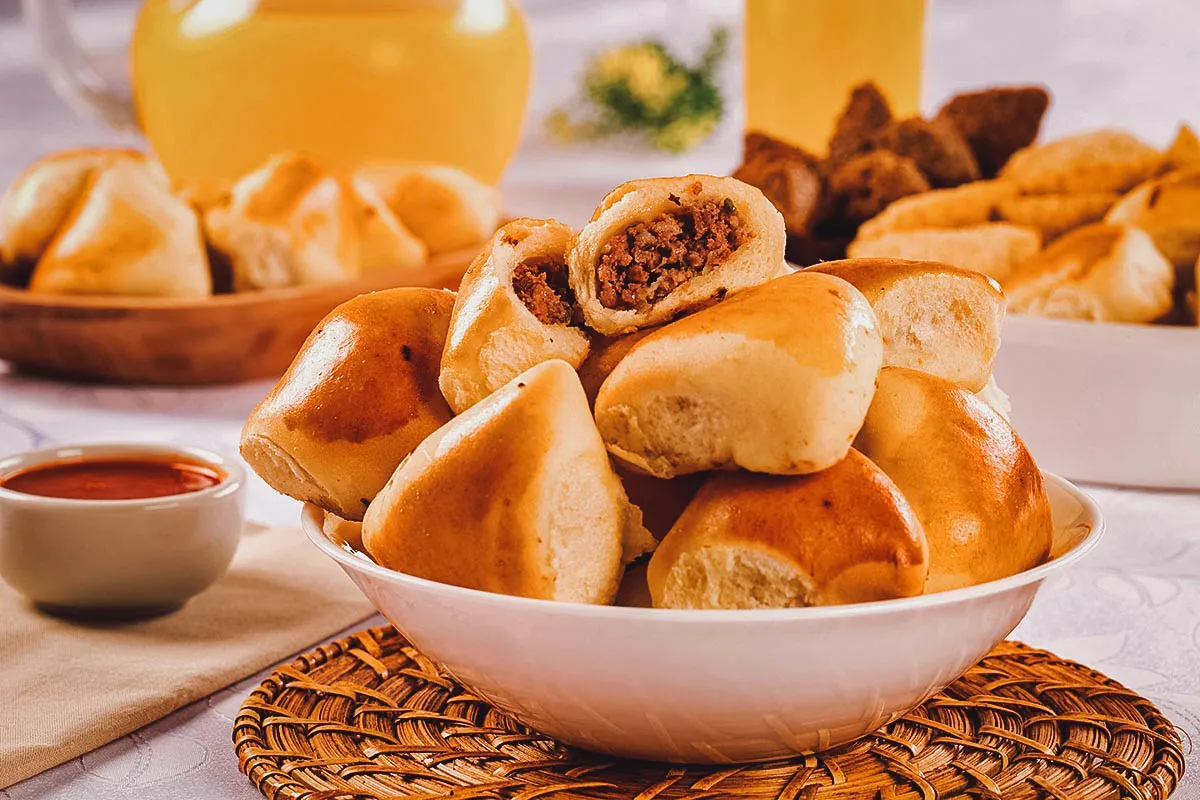
Photo by Paulovilela
13. Tapioca
Tapioca refers to a type of thin flatbread made from cassava root. It’s popular in many countries throughout Latin America like Brazil, Venezuela, Cuba, Colombia, Belize, and the Dominican Republic.
To make tapioca, cassava root is ground to a pulp and squeezed in a sebucan (tube-shaped pressure strainer) to expel the bitter toxic liquid known as yare. The pulp is then spread on a griddle and toasted to create thin round flatbreads similar to tortilla.
Tapioca can be eaten on its own or with other dishes and ingredients. Thin and crispy tapioca can be broken apart and eaten like crackers while thicker flatbreads can be moistened with water to make them soft like bread.
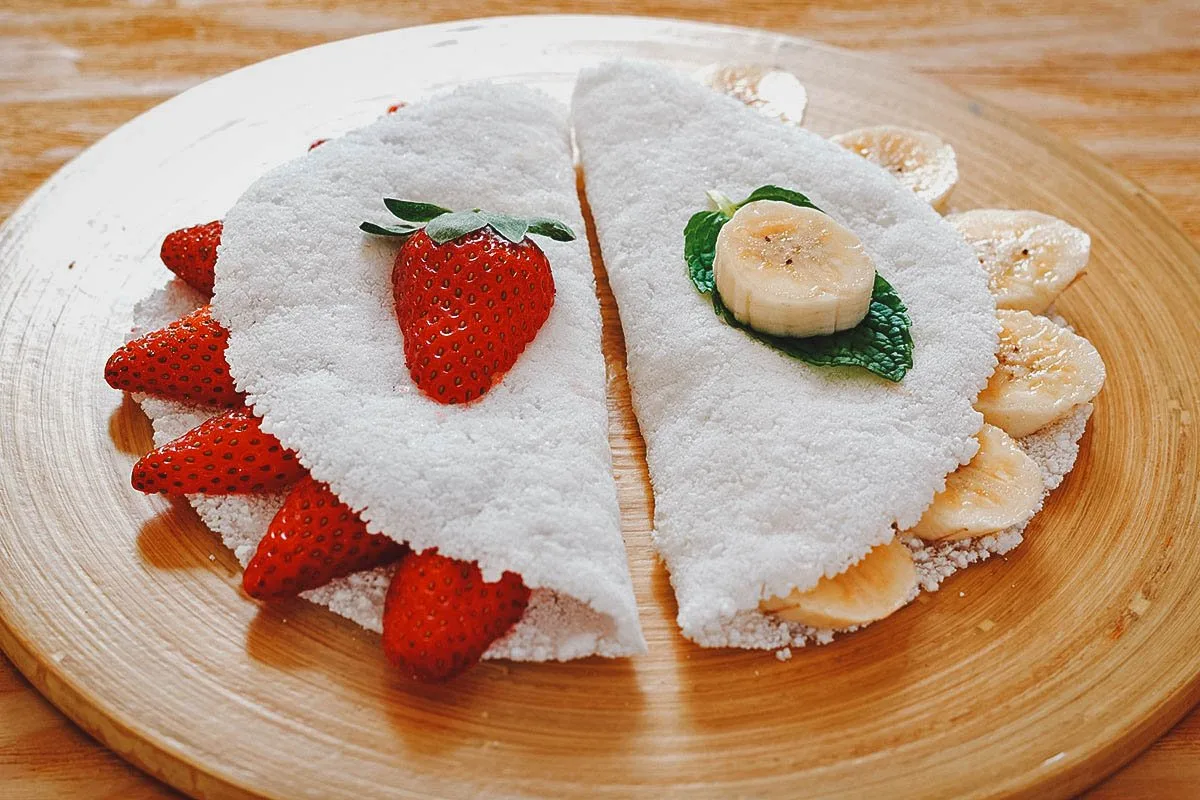
Photo by jantroyka
RICE / BEANS
14. Acarajé
Acarajé refers to a type of spicy Brazilian fritter made with black-eyed peas. Popular in the cuisines of many Caribbean and West African countries, it’s typically associated with Bahia in Brazil where it’s known to be the most popular street food and beach snack.
To make acarajé, skinned black-eyed peas are seasoned with ground shrimp and onions and then shaped into balls before being deep-fried in dendê palm oil. When cooked, they’re split in half and filled with various ingredients like shrimp, caruru (okra stew), and vatapa – a puree of fish, dried shrimp, nuts, and soaked bread.
This is what it looks like before it’s been split in half and filled with the different ingredients.

Photo by Jaboticapa Images
Pictured below is acarajé filled with vatapa and shrimp. Like many of the dishes in this Brazilian food guide, it was brought to Brazil by former slaves and is one of the best examples of the profound West African influence on Brazilian culture and cuisine.
Today, you’ll find over 500 acarajé vendors in Salvador (capital of Bahia), most of whom are women. Easily recognizable for their all-white cotton dresses and headscarves, these women form such an important part of the local identity that they’re often featured in artworks depicting the region of Bahia.
It’s worth mentioning that the real name of this dish in Nigerian cuisine is akara. These women vendors from Salvador would shout “Acara-jé!” – meaning “I have akara!” – which is how the dish got its name in Brazil.

Photo by Jaboticapa Images
15. Abará
Like acarajé, abará is an Afro-Brazilian dish from Bahia. It’s very similar to acarajé except it’s steamed instead of being deep-fried in dendê palm oil.
To make, black-eyed peas are soaked, skinned, and then mashed into a paste before being wrapped and steamed in banana leaves. When ready, it’s traditionally served still wrapped in banana leaf and accompanied with freshly made hot chili sauce.

Photo by casadaphoto
16. Feijoada
No Brazilian food guide worth its weight in salt can go without feijoada, the national dish of Brazil. The name feijoada stems from the Portuguese word feijão, meaning “bean”, and refers to a hearty Brazilian stew made with beans, beef, and pork. It’s believed to be an adaptation of a pork and vegetable stew from the Minho province of northern Portugal.
There are about as many Brazilian recipes for feijoada as there are cooks. It exists in many variations throughout the country, some of the most well-known recipes coming from the kitchens of Rio de Janeiro, Sãu Paolo, Salvador, and Recife.
At its most basic, feijoada is made with black beans slow-cooked in a thick clay pot with salted beef and pork, bacon, garlic, onions, bay leaves, and seasonings. Depending on where it’s from, it can be made with additional ingredients like potatoes, plantains, carrots, cabbage, carne de sol (sun-dried beef), and other cuts of meat.
Feijoada is a comforting dish and perhaps the best example of Brazilian soul food. Strong-tasting and mildly salty but not spicy, it’s usually served with rice, collard greens, orange slices, and farofa. In São Paulo, Brazilian restaurants serve it on Wednesdays and Saturdays while restaurants in Rio de Janeiro typically offer it on Fridays. It’s a tradition inherited from the Portuguese who liked to associate days of the week with certain dishes.
When made at home, feijoada is usually eaten over the weekends with family, as a leisurely dish meant to be enjoyed throughout the day.

Photo by Jaboticapa Images
17. Tutu de Feijão
Tutu de feijão refers to a traditional dish of mashed beans thickened with cassava flour (or corn flour). It’s originally from Minas Gerais – hence the alternative name Tutu à Mineira – but it’s become popular throughout Brazil, especially in Rio de Janeiro and São Paulo.
Tutu de feijão is made by mixing puréed beans with cassava flour and other ingredients like bacon, garlic, onions, parsley, bay leaves, and olive oil. In Minas Gerais and Rio de Janeiro, it’s traditionally made with black beans but in São Paulo, brown beans are preferred.
No matter where it’s from, tutu de feijão is always served with rice, vegetables, and meat. Like many of the dishes in this Brazilian food guide, it’s believed to be African in origin.

Photo by robertohunger
18. Arroz com Pequi
Arroz com pequi is a traditional Brazilian rice dish hailing from the central states of Goiás and Minas Gerais. Its key ingredient is pequi, a small seasonal fruit with a strong cheese-like flavor. Like tomato, it’s a fruit that’s treated more like a vegetable and used in savory dishes like arroz com pequi.
Arroz com pequi is made by simmering pequi with rice and other ingredients like garlic, onions, chicken broth, vegetable oil, and seasonings. After the rice absorbs all the liquid and becomes tender, chopped green onions are often stirred into the dish before serving.

Photo by trindade51
19. Baião de Dois
Baião de dois is a classic dish of rice and beans from the northeast region of Brazil. It’s originally from Ceará though it now exists in many variations throughout the country.
Brazilian recipes for baião de dois vary but at its core, it’s made with rice and Brazilian beans – preferably feijão verde or feijão novo – cooked with other ingredients like onions, tomatoes, peppers, chives, herbs, and spices. Depending on the cook, you may find versions made with beef (carne de sol), pork, or cheese as well.
Interestingly, the dish was popularized by musicians Humberto Teixeira and Luís Gonzaga in a song called “Baião-de-dois”. It literally means “baião for two” and is in reference to a music and dance style typical of the northeast region. The “two” in the name refers to beans and rice cooked together, as if in a close embrace while dancing the baião.
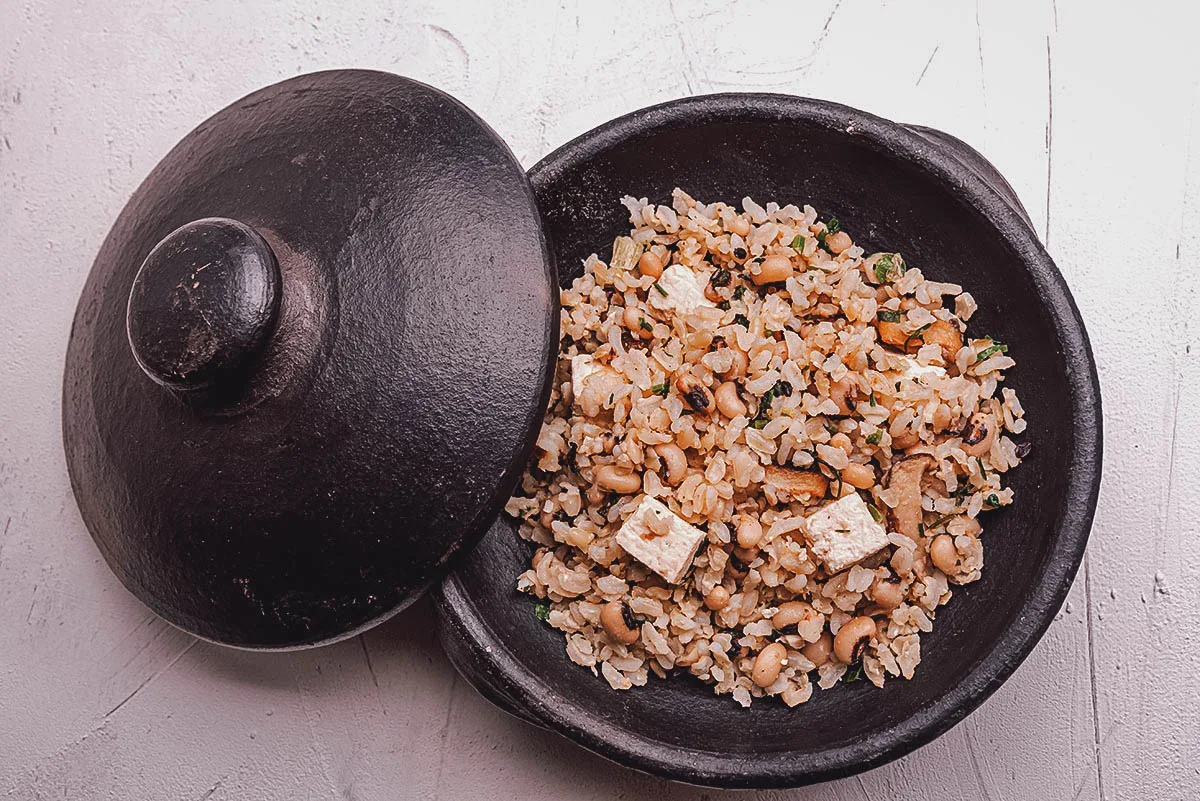
Photo by romualdocrissi
20. Galinhada
Galinhada refers to a hearty Brazilian stew made with chicken and rice. It’s traditionally associated with the central regions of Goiás and Minas Gerais though it’s now widely consumed throughout Brazil.
Galinhada can be found at any typical Brazilian restaurant but it’s also commonly prepared at home. There are as many Brazilian recipes for galinhada as there are cooks but at its core, it’s made with rice, chicken (preferably free-range), and spices. Depending on where it’s from, it can be made with any number of additional local ingredients like okra, pequi, and gabiroba.
Galinhada can be enjoyed at any time of the year though it’s traditionally made on Holy Saturday to celebrate the end of Lent. It’s also touted as a hangover cure, its effectiveness summarized in this Brazilian saying: “O que a pinga estraga, a galinha cura“, meaning “What the pinga (Brazilian spirit) ruins, the hen cures.”
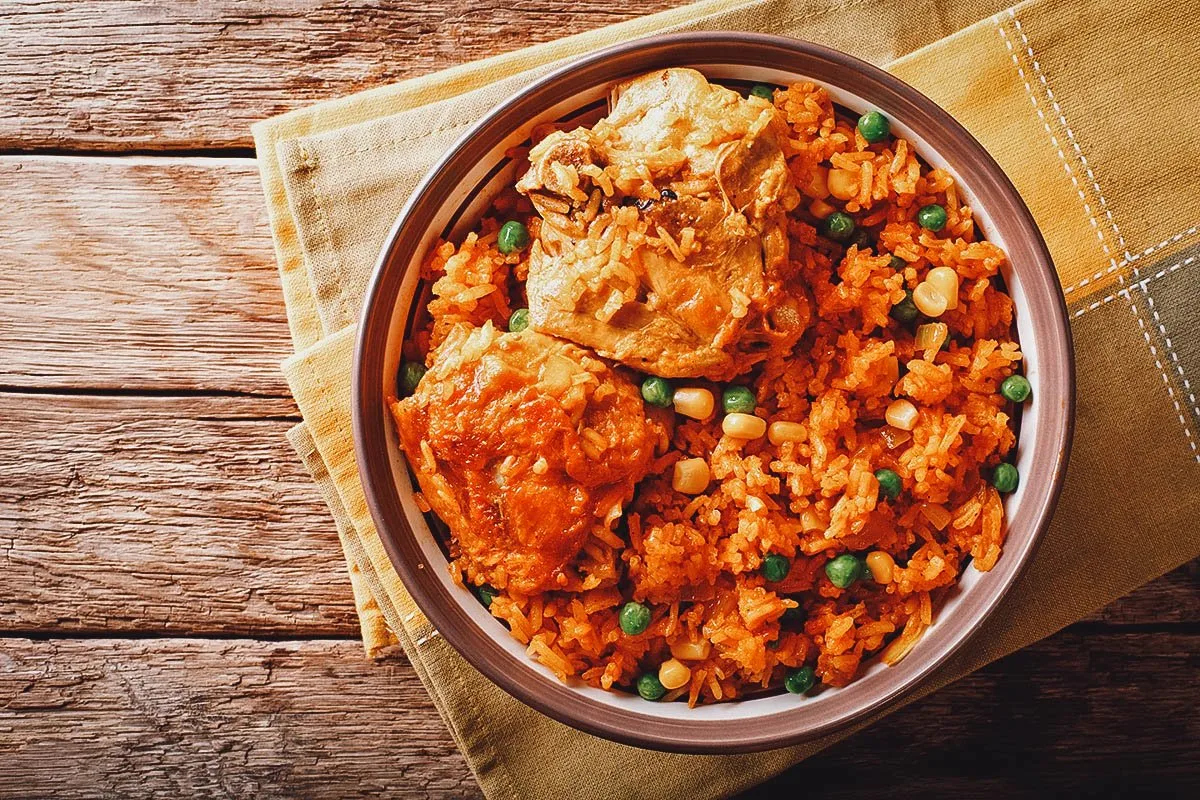
Photo by lenyvavsha
MEATS / MAINS
21. Churrasco
Carnivores will surely be salivating over this next dining experiencen in Brazil. Similar to an Argentinian asado or South African braai, churrasco refers to a Brazilian barbecue consisting of large skewers of beef, pork, lamb, chicken, veal, and sausages grilled over a wood fire. It’s a dining tradition that dates back to the early 19th century, when gauchos (skilled horsemen) would skewer large chunks of meat and slowly grill them over a fire.
Today, enjoying different cuts of grilled meat at a churrascaria or rodízio (Brazilian all-you-can-eat barbecue restaurant) is one of the most satisfying dining experiences you can have in Brazil. Not only is it delicious, but it’s loads of fun too. Servers will walk around the restaurant with freshly grilled skewers of meat. If you see something you like, just flag them down and they’ll cut thick slices of it directly onto your plate.
The meats are the star but a churrasco is a complete Brazilian meal that starts with appetizers and salads from a buffet. The meats are paired with a variety of side dishes like farofa, Brazilian rice, potatoes, black beans, fried bananas, and chili-based sauces. It’s a hefty meal so be sure to arrive hungry. Bom apetite!
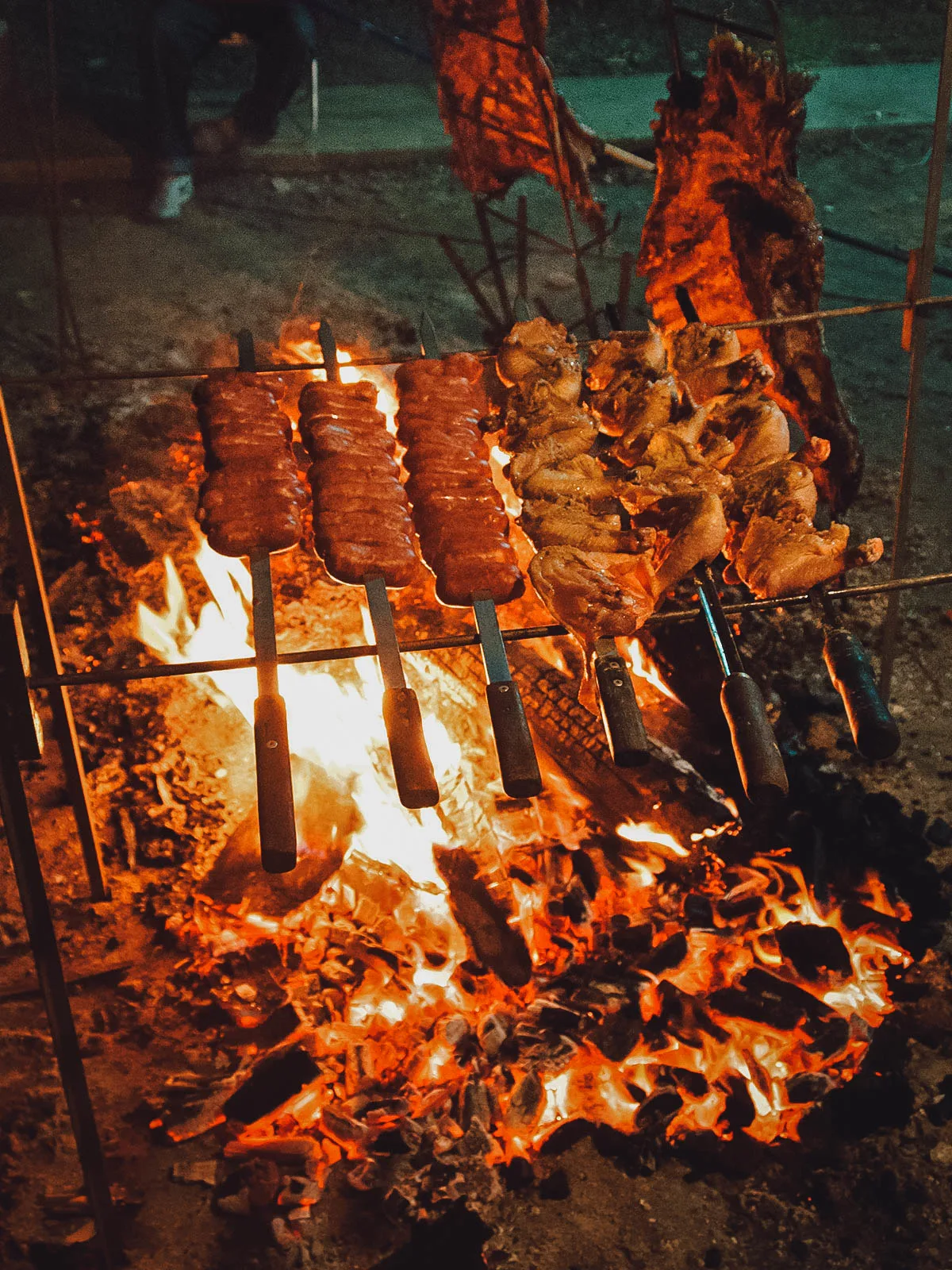
Photo by brizardh
You can enjoy a wide variety of grilled meats at a churrascaria in Brazil like filet mignon, sirloin steak, roast beef, lamb, pork ribs, chouriço, and chicken hearts. Yes, chicken hearts!
Everything is usually delicious but one of the best has to be picanha, the Brazilian word for a lesser-known cut of meat otherwise known as rump cover or top sirloin cap. It consists of a top piece of sirloin attached to a thick cap of fat. Don’t miss it!

Photo by rocharibeiro
22. Escondidinho
Escondidinho refers to a traditional Brazilian casserole. Similar to shepherd’s pie, it’s made with a filling of spiced meat topped with a layer of mashed potatoes and cheese.
According to this Brazilian food blogger, the original version of escondidinho may have been made with carne seca (dried beef) and mashed yucca but it can now be made with a variety of proteins like chicken, beef, pork, shrimp, and fish. The seasoned and cooked meat is layered in a dish and then topped with mashed potatoes and grated cheese before baking.

Photo by agphotography
FRUITS / NUTS / CHEESE
23. Açaí
If you’ve seen those picture-perfect smoothie bowls on Instagram, then this next dish (or ingredient) may be familiar to you. Açaí refers to the berries of the açaí palm, a species of palm tree native to Brazil and other countries in South America like Venezuela, Ecuador, Colombia, and Guyana. In recent years, it’s been touted as a superfood rich in antioxidants, fiber, healthy fats, and calcium.
Açaí can be consumed in many ways but in Brazil, it’s commonly eaten in a dessert called açaí na tigela. It consists of mashed açaí berries served in a bowl with different fruits, granola, and guaraná syrup.
MMA fans will be pleased to learn that açaí bowls were poularized in the 1980s by legendary Brazilian jiu-jitsu practitioner Carlos Gracie. He formulated a special diet to increase the performance of his fighters, at the center of which is the açaí bowl.

Photo by diogoppr
Aside from açaí bowls, you can also enjoy these berries in smoothies. Açaí smoothies are made with açaí powder blended with different types of fruit and milk.
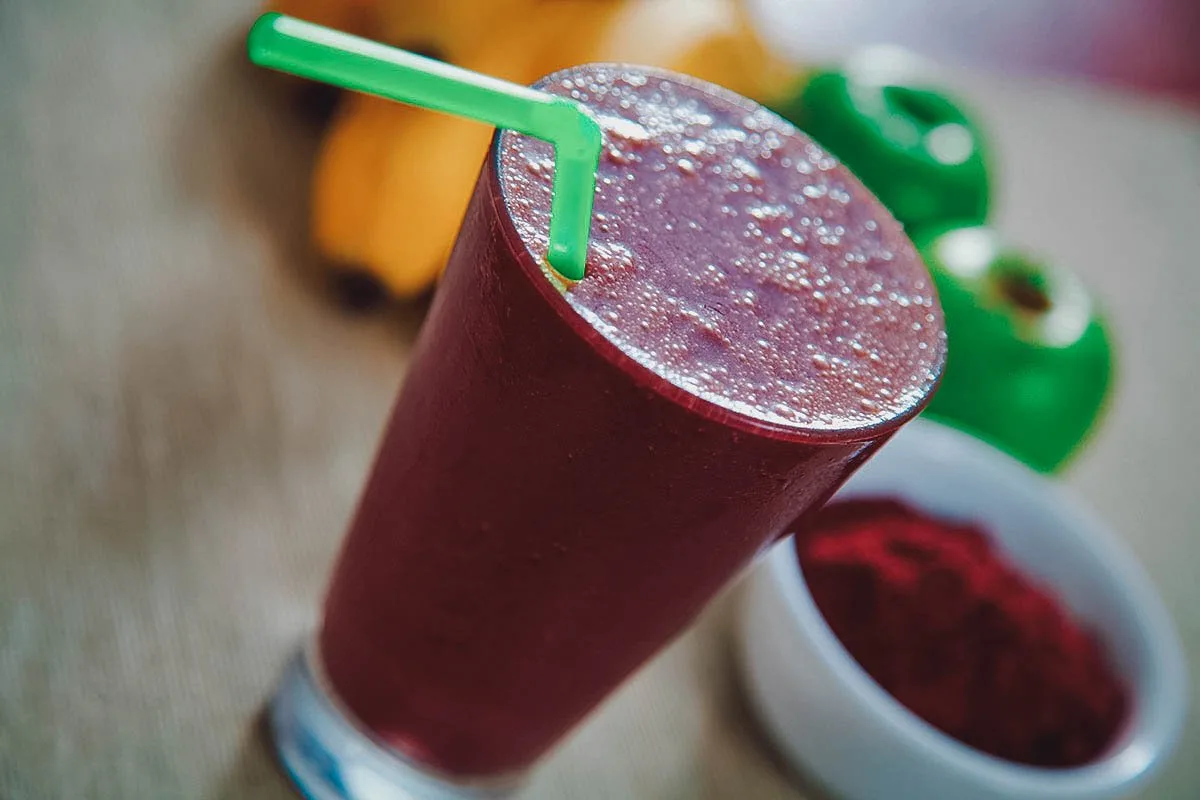
Photo by zstockphotos
24. Brazil Nuts
Like açaí berries, Brazil nuts are a highly nutritious food source native to the Amazon rainforests of Brazil, Peru, and Bolivia. They’re high in dietary fiber, vitamins, and minerals and is one of the richest sources of selenium, a mineral that supports thyroid function and enhances your immune system.
Like any edible nut, Brazil nuts can be eaten on their own or they can be mixed into various recipes like salads, breads, cakes, and savory dishes.
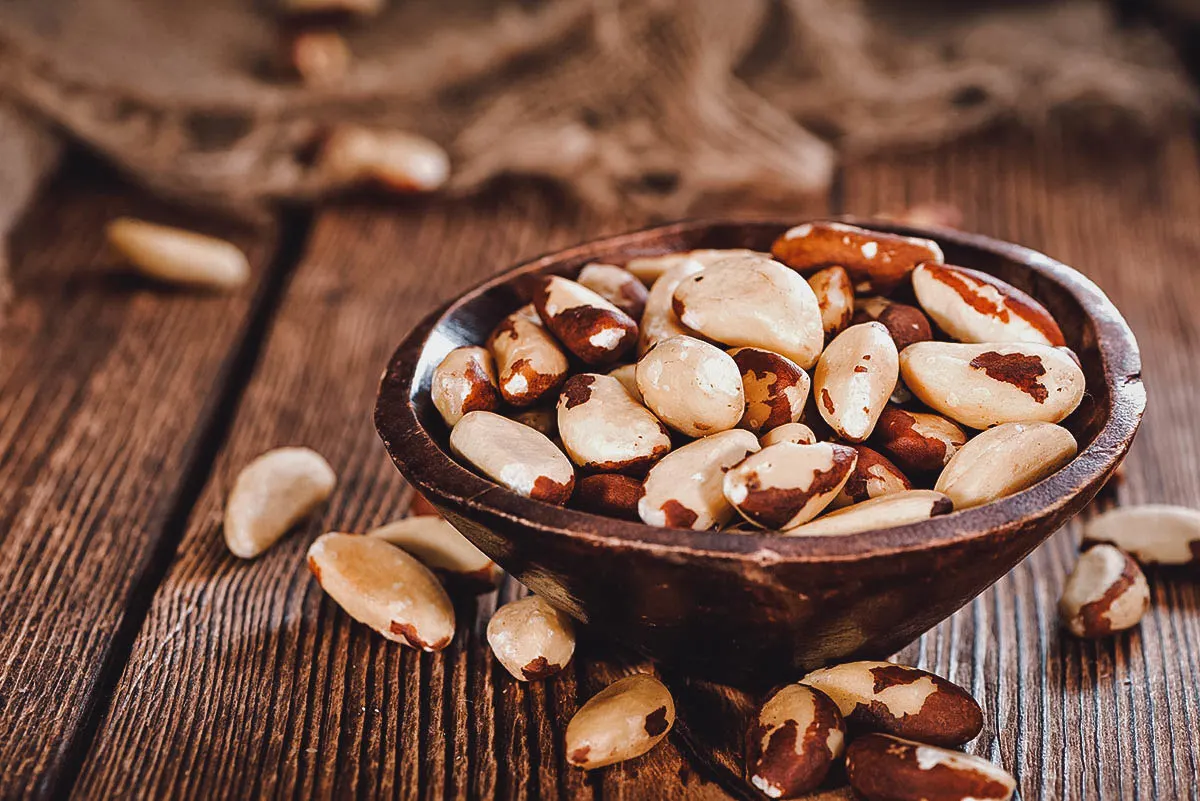
Photo by HandmadePicture
25. Pinhão
Pinhão is the local term for the araucaria pine nut, a large edible seed that comes from the paraná or Brazilian pine tree. Harvested every winter, they’ve been a valuable food source for the indigenous people of southern Brazil for hundreds of years.
Pinhão are typically roasted and eaten on their own or mixed into Brazilian dishes like paçoca de pinhão (minced meat with pine nuts) or entrevero (Brazilian stew). They can also be ground into a flour and used in cakes. When eaten on their own, they have a flavor reminiscent of chestnuts.
If you visit the southern states of Brazil in winter, it’s common to find vendors selling pinhão on the side of the street.
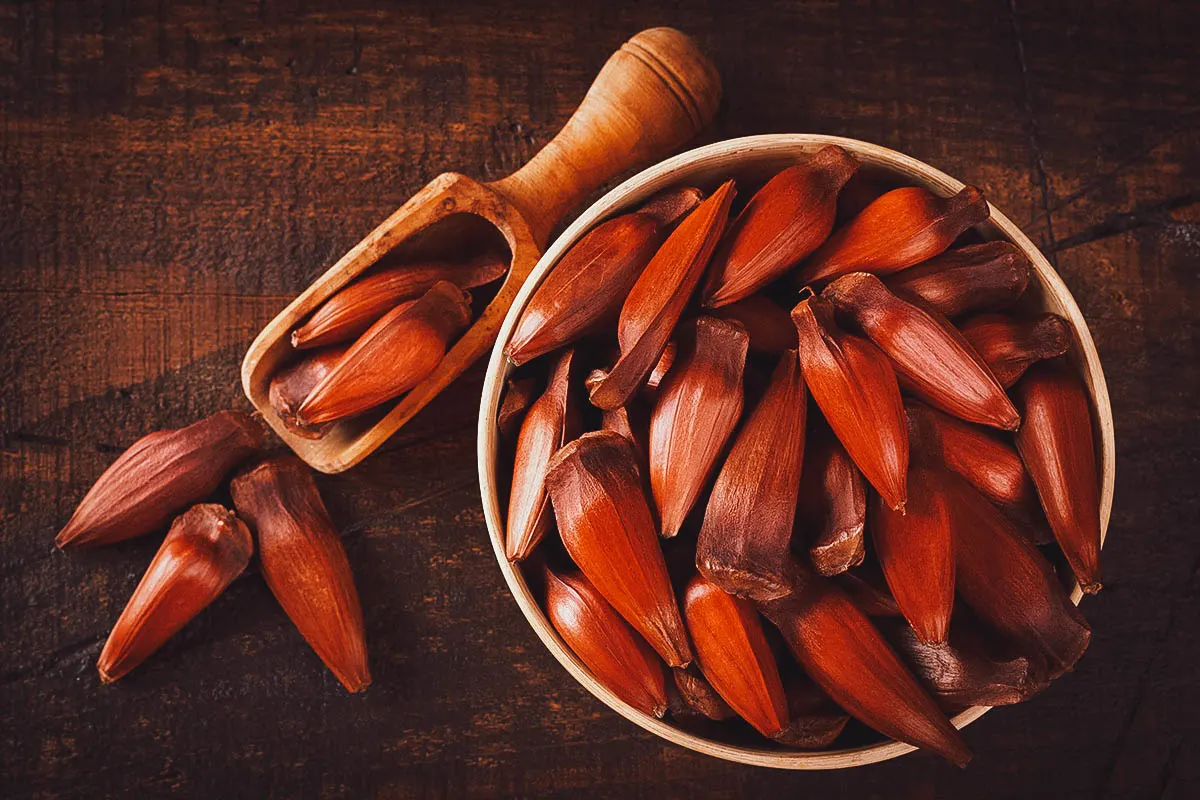
Photo by jantroyka
26. Queijo Coalho
Queijo coalho literally means “curd cheese” and refers to a firm but light cheese from northeastern Brazil. It’s typically skewered and grilled over charcoal and sold as street food at Brazilian markets.
When served piping hot, queijo coalho has a crispy golden brown exterior and a soft, near-molten interior. It’s typically seasoned with dried oregano or an oil and garlic sauce before eating.
Aside from being a popular street food snack in Brazil, queijo coalho is also a common sight at homemade churrascos.
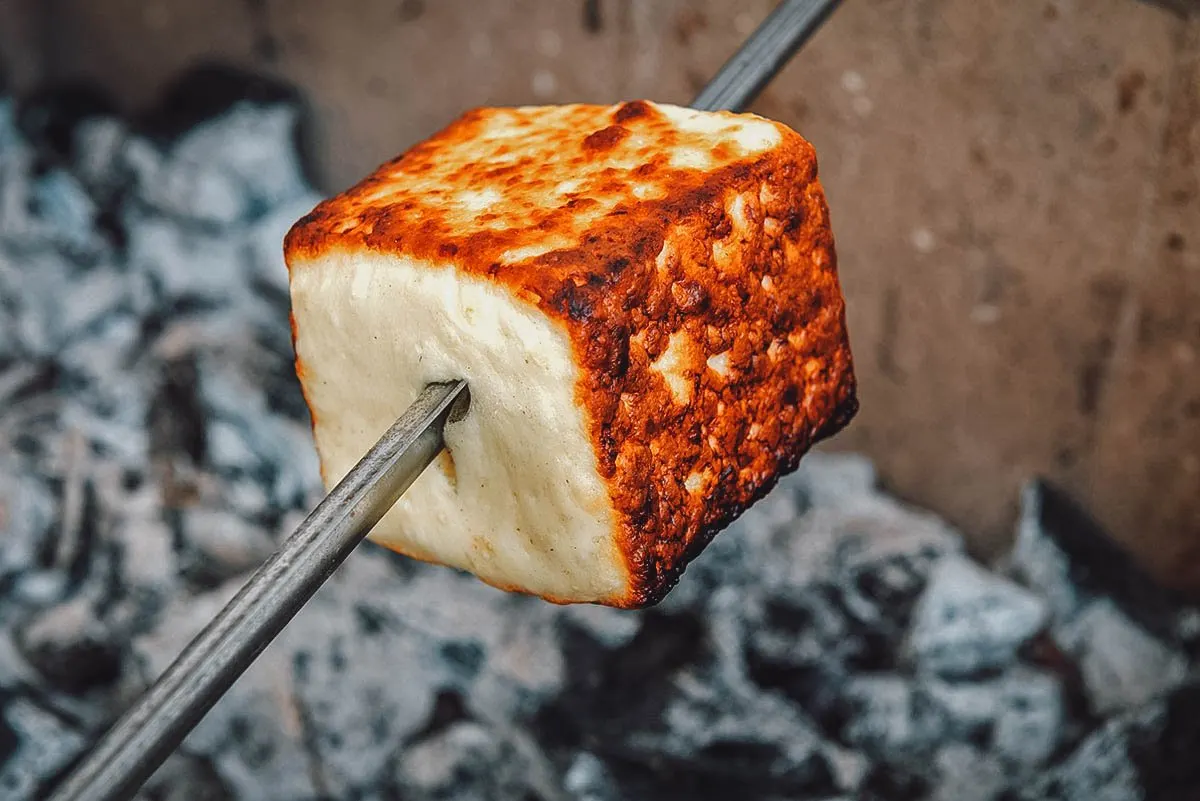
Photo by vtupinamba
DESSERTS / DRINKS
Be sure to check out our article on traditional Brazilian desserts for a more extensive list of tasty sweet treats!
27. Brigadeiro
Brazilians with a sweet tooth have probably eaten hundreds if not thousands of these hugely popular fudge balls coated in chocolate sprinkles. The brigadeiro is a classic Brazilian dessert and perhaps the most well-known and beloved birthday party treat.
The brigadeiro is a simple dessert made with sweetened condensed milk, chocolate powder (or cocoa powder), and butter. Similar to chocolate truffle or bon-bons, they’re shaped into bite-sized balls and rolled in chocolate sprinkles before being served in small paper cups. It’s a classic sweet treat that many Brazilians grew up eating.
The name brigadeiro means “brigadier” and is said to be in reference to Eduardo Gomes, a Brazilian brigadier who ran for president in 1946. One of his supporters, Heloísa Nabuco de Oliveira, created this sweet and named it doce do brigadeiro (“brigadier’s sweet”) in honor of Gomes. The dessert quickly became popular with the name eventually shortened to just brigadeiro.
Brigadeiros are traditionally made with chocolate but you can now find versions made with other ingredients like white chocolate, pistachio, Nutella, and passion fruit.
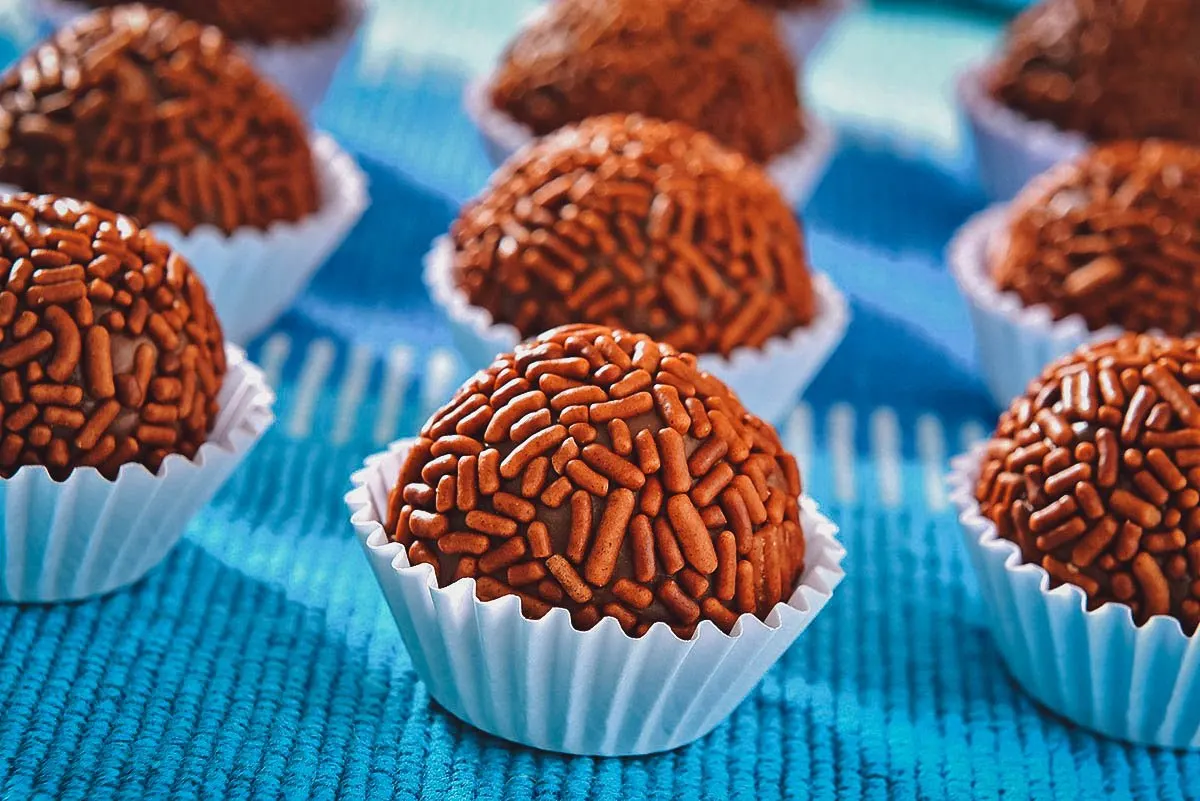
Photo by MKPK
28. Beijinho de Coco
Beijinho de coco means “little coconut kiss” in Portuguese and refers to this Brazilian confection made with grated coconut, sweetened condensed milk, butter, and granulated sugar. They’re essentially coconut fudge balls rolled in granulated sugar or shredded coconut and topped with a single decorative clove.
Beijinhos are almost as popular as brigadeiros and present at nearly every Brazilian birthday party. They can also be referred to as branquinhos, meaning “little white ones”.
Beijinhos are commonly made with coconut but they can also be made with other flavoring ingredients like passion fruit, strawberry gelatin, and cocoa powder.
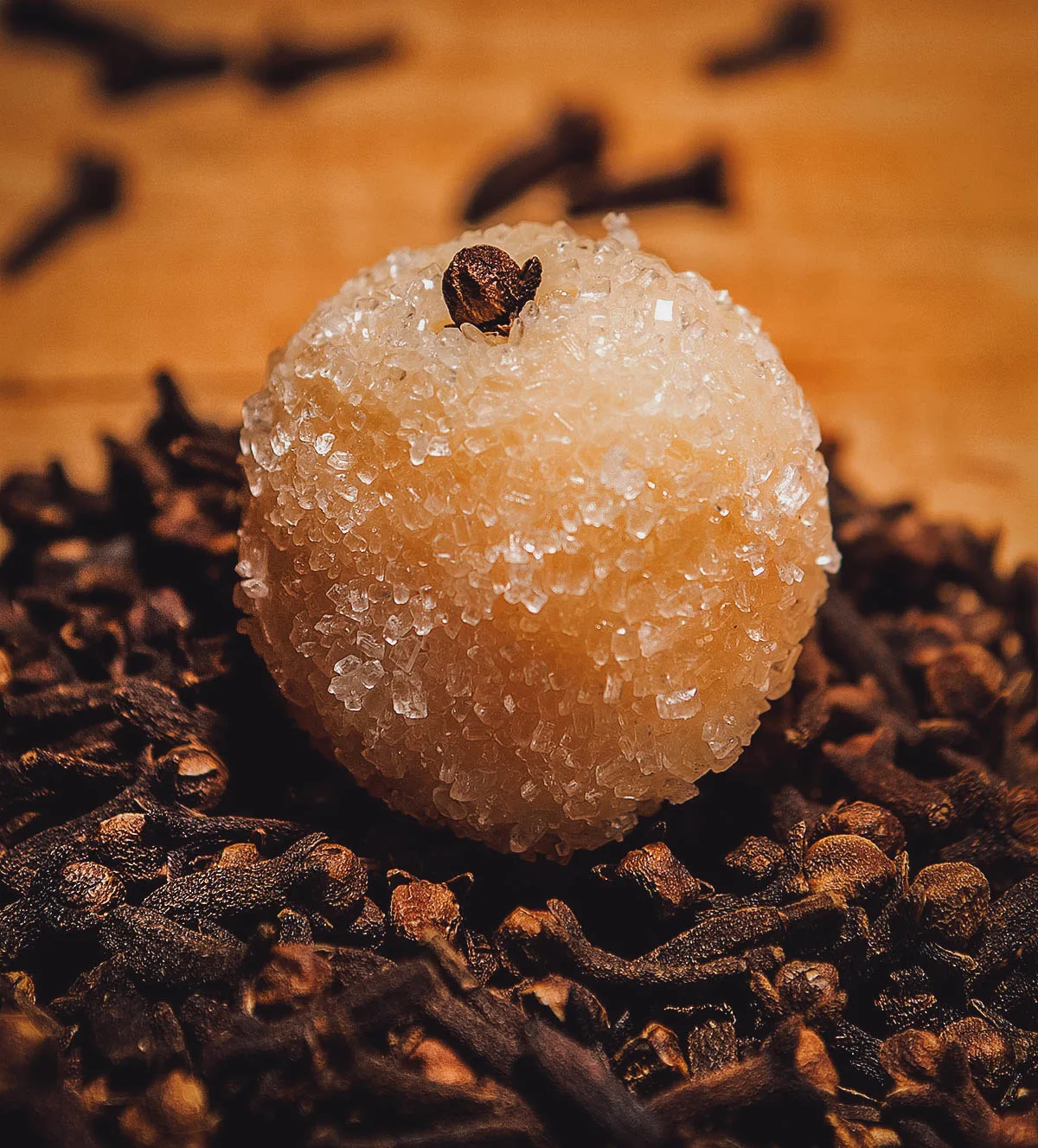
Photo by diogoppr
29. Paçoca de Amendoim
As previously described, Festa Junina is an annual Brazilian festival that commemorates St. Anthony, St. John, and St. Peter. It’s celebrated with many traditional festival dishes like pamonha, canjica, curau, and this Brazilian peanut candy known as paçoca de amendoim.
Popular in southeastern Brazil, paçoca de amendoim is a simple but tasty treat made with ground peanuts, sugar, and salt. It’s name means “to crumble” or “to smash” and is in reference to the way it was traditionally made using a mortar and pestle.

Photo by jantroyka
30. Caipirinha
Caipirinha is the national cocktail of Brazil. It’s the mother of all Brazilian cocktails and made with just three ingredients – lime, sugar, and cachaça, a type of Brazilian liquor distilled from fresh sugarcane juice.
According to this Brazilian food blogger, capirinha evolved from a classic home remedy to treat the common cold. In the early 20th century, people were treating colds with a mixture of cachaça, garlic, lemon, and honey. Over time, honey was replaced with sugar and garlic was omitted from the recipe. The drink grew in popularity and started to be enjoyed as a cocktail and not just a home remedy.
According to the story, the drink evolved from remedy to cocktail in the rural areas of São Paulo, where people are referred to as caipira. Caipirinha is the diminutive form of caipira and essentially means “hillbilly”.
Today, caipirinha is enjoyed everywhere in Brazil. Aside from bars and restaurants, many Brazilian families make it at home to wash down weekend meals of churrasco or feijoada.
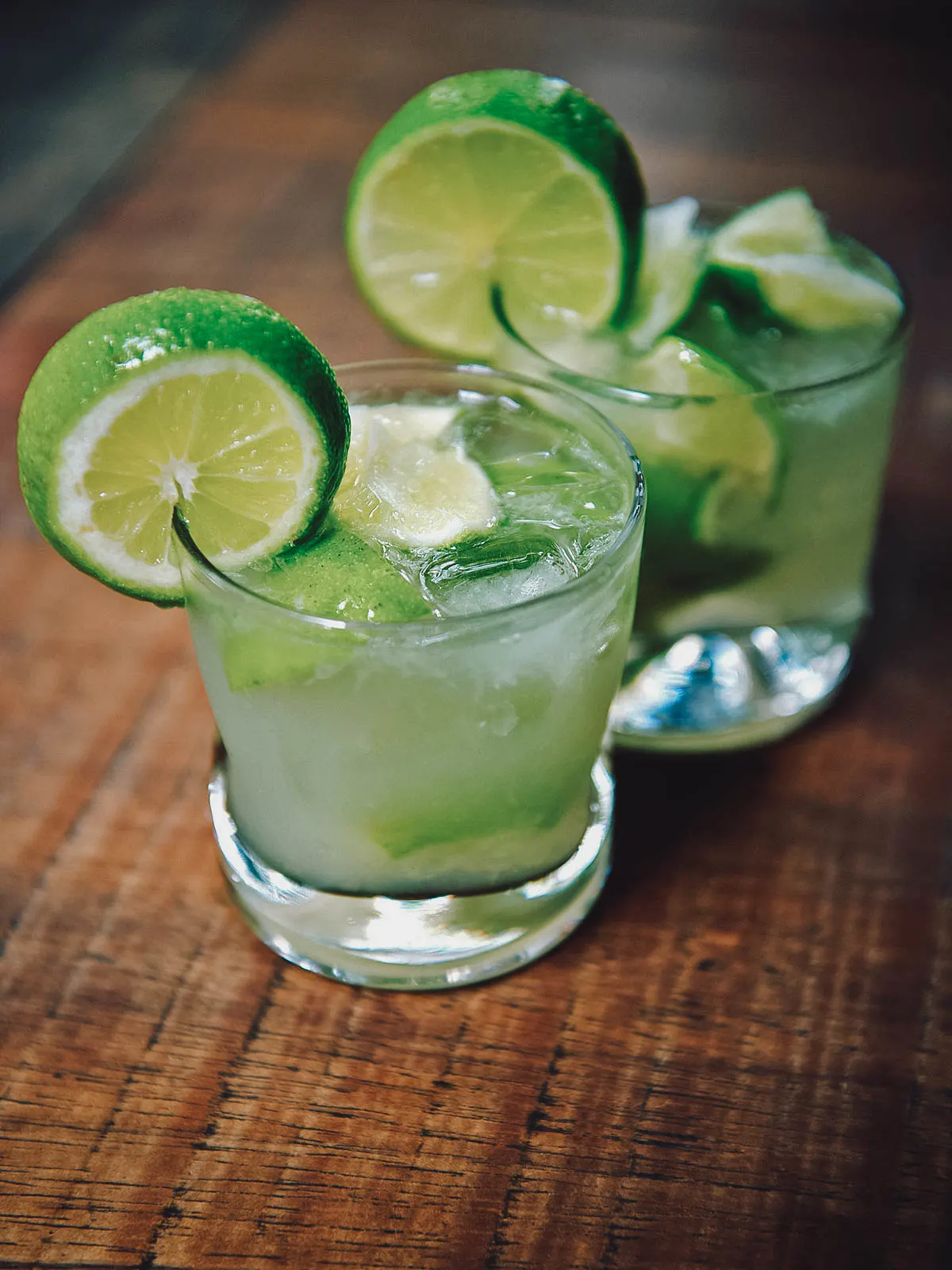
Photo by Lazyllama
FINAL THOUGHTS ON TRADITIONAL BRAZILIAN FOOD
There are many interesting sights and attractions in Brazil, but as outlined in this Brazilian food guide, there are many delicious dishes to look forward to as well.
Considering how much there is to taste and experience in Brazil, a list of thirty dishes barely scratches the surface. But we do we hope it whets your appetite and gets you even more excited to visit this unique and vibrant country in South America. Bom apetite!
Cover photo by rocharibeiro. Stock images via Depositphotos.


sendy
Saturday 29th of October 2022
I am sendy and I like learning about Brazil hahahaha
Richard Visconte
Tuesday 8th of March 2022
Love the site with all the history behind each dish.any recommendation for the recipes, cook book, chef?
JB & Renée
Tuesday 8th of March 2022
That's a great suggestion Richard. We'll add links to authentic recipes on the next article update. Thanks!
Liliane Silva
Wednesday 26th of January 2022
Great article, couple more missing dishes: Maionese and salpicão de frango.
JB & Renée
Thursday 27th of January 2022
Thank you for the recommendations Liliane!
Gloria W
Saturday 4th of December 2021
The article is accurate but the name of the dish in Brazil is tapioca not casabe.
JB & Renée
Monday 6th of December 2021
Many thanks Gloria, I've corrected the article. Cheers!
jane henninger
Sunday 28th of November 2021
You didn't say anything about Guarana the soft drink.
Duff
Sunday 20th of August 2023
@jane henninger, guaraná is a soft drink, nor isn't a national dish